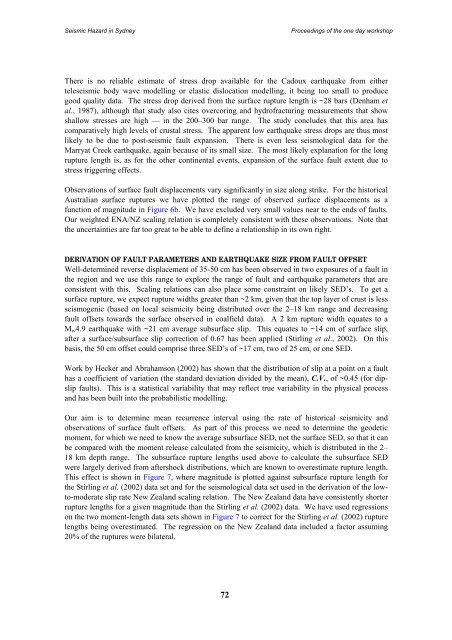Landslides in the Sydney Basin - Geoscience Australia
Landslides in the Sydney Basin - Geoscience Australia
Landslides in the Sydney Basin - Geoscience Australia
- No tags were found...
Create successful ePaper yourself
Turn your PDF publications into a flip-book with our unique Google optimized e-Paper software.
Seismic Hazard <strong>in</strong> <strong>Sydney</strong>Proceed<strong>in</strong>gs of <strong>the</strong> one day workshopThere is no reliable estimate of stress drop available for <strong>the</strong> Cadoux earthquake from ei<strong>the</strong>rteleseismic body wave modell<strong>in</strong>g or elastic dislocation modell<strong>in</strong>g, it be<strong>in</strong>g too small to producegood quality data. The stress drop derived from <strong>the</strong> surface rupture length is ~28 bars (Denham etal., 1987), although that study also cites overcor<strong>in</strong>g and hydrofractur<strong>in</strong>g measurements that showshallow stresses are high — <strong>in</strong> <strong>the</strong> 200–300 bar range. The study concludes that this area hascomparatively high levels of crustal stress. The apparent low earthquake stress drops are thus mostlikely to be due to post-seismic fault expansion. There is even less seismological data for <strong>the</strong>Marryat Creek earthquake, aga<strong>in</strong> because of its small size. The most likely explanation for <strong>the</strong> longrupture length is, as for <strong>the</strong> o<strong>the</strong>r cont<strong>in</strong>ental events, expansion of <strong>the</strong> surface fault extent due tostress trigger<strong>in</strong>g effects.Observations of surface fault displacements vary significantly <strong>in</strong> size along strike. For <strong>the</strong> historical<strong>Australia</strong>n surface ruptures we have plotted <strong>the</strong> range of observed surface displacements as afunction of magnitude <strong>in</strong> Figure 6b. We have excluded very small values near to <strong>the</strong> ends of faults.Our weighted ENA/NZ scal<strong>in</strong>g relation is completely consistent with <strong>the</strong>se observations. Note that<strong>the</strong> uncerta<strong>in</strong>ties are far too great to be able to def<strong>in</strong>e a relationship <strong>in</strong> its own right.DERIVATION OF FAULT PARAMETERS AND EARTHQUAKE SIZE FROM FAULT OFFSETWell-determ<strong>in</strong>ed reverse displacement of 35-50 cm has been observed <strong>in</strong> two exposures of a fault <strong>in</strong><strong>the</strong> region and we use this range to explore <strong>the</strong> range of fault and earthquake parameters that areconsistent with this. Scal<strong>in</strong>g relations can also place some constra<strong>in</strong>t on likely SED’s. To get asurface rupture, we expect rupture widths greater than ~2 km, given that <strong>the</strong> top layer of crust is lessseismogenic (based on local seismicity be<strong>in</strong>g distributed over <strong>the</strong> 2–18 km range and decreas<strong>in</strong>gfault offsets towards <strong>the</strong> surface observed <strong>in</strong> coalfield data). A 2 km rupture width equates to aM w 4.9 earthquake with ~21 cm average subsurface slip. This equates to ~14 cm of surface slip,after a surface/subsurface slip correction of 0.67 has been applied (Stirl<strong>in</strong>g et al., 2002). On thisbasis, <strong>the</strong> 50 cm offset could comprise three SED’s of ~17 cm, two of 25 cm, or one SED.Work by Hecker and Abrahamson (2002) has shown that <strong>the</strong> distribution of slip at a po<strong>in</strong>t on a faulthas a coefficient of variation (<strong>the</strong> standard deviation divided by <strong>the</strong> mean), C.V., of ~0.45 (for dipslipfaults). This is a statistical variability that may reflect true variability <strong>in</strong> <strong>the</strong> physical processand has been built <strong>in</strong>to <strong>the</strong> probabilistic modell<strong>in</strong>g.Our aim is to determ<strong>in</strong>e mean recurrence <strong>in</strong>terval us<strong>in</strong>g <strong>the</strong> rate of historical seismicity andobservations of surface fault offsets. As part of this process we need to determ<strong>in</strong>e <strong>the</strong> geodeticmoment, for which we need to know <strong>the</strong> average subsurface SED, not <strong>the</strong> surface SED, so that it canbe compared with <strong>the</strong> moment release calculated from <strong>the</strong> seismicity, which is distributed <strong>in</strong> <strong>the</strong> 2–18 km depth range. The subsurface rupture lengths used above to calculate <strong>the</strong> subsurface SEDwere largely derived from aftershock distributions, which are known to overestimate rupture length.This effect is shown <strong>in</strong> Figure 7, where magnitude is plotted aga<strong>in</strong>st subsurface rupture length for<strong>the</strong> Stirl<strong>in</strong>g et al. (2002) data set and for <strong>the</strong> seismological data set used <strong>in</strong> <strong>the</strong> derivation of <strong>the</strong> lowto-moderateslip rate New Zealand scal<strong>in</strong>g relation. The New Zealand data have consistently shorterrupture lengths for a given magnitude than <strong>the</strong> Stirl<strong>in</strong>g et al. (2002) data. We have used regressionson <strong>the</strong> two moment-length data sets shown <strong>in</strong> Figure 7 to correct for <strong>the</strong> Stirl<strong>in</strong>g et al. (2002) rupturelengths be<strong>in</strong>g overestimated. The regression on <strong>the</strong> New Zealand data <strong>in</strong>cluded a factor assum<strong>in</strong>g20% of <strong>the</strong> ruptures were bilateral.
















